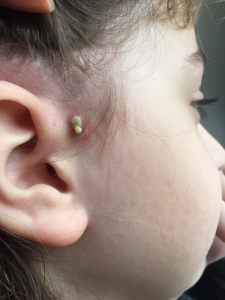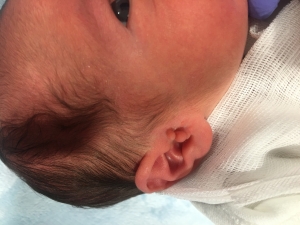There is a skin tag in front of my baby’s ear?
July 2024
Sometimes, regardless of whether it’s a baby, child, or adult, you might see a piece of flesh in front of the ear, or if you look closely, there might be a tiny hole in front of the ear… In this entry of the pediatric surgeon’s logbook, I will explain these structures left over from the embryological period, known as “preauricular skin tags and pits,” why they occur, when intervention is necessary, and the problems they might cause.
It’s difficult to translate exactly into Turkish. Let me first talk a bit about preauricular pits or sinuses. As the name suggests, they are located in front of the ear, usually on the right side, but they can be on both ears in about 25-50% of cases. They are found in about 0.5-1% of the population and are known to be hereditary.
They can be associated with some important conditions such as deafness, kidney abnormalities, and other congenital anomalies and syndromes. If a baby has a preauricular pit, we should never skip ear screening tests and should pay attention to any syndromes or craniofacial abnormalities that might be associated, especially if they are present in both ears.
Preauricular pits are associated with other congenital anomalies and syndromes in about 3-10% of cases. Kidney abnormalities are frequently questioned. If the pit is isolated, meaning the other examinations, face, head, and ears are normal, they are not known to differ from the general population.
How do we treat them? If they are not causing any problems, there is no need to touch them.

However, if there is discharge, as seen in the photo, or if an infection develops, it needs to be removed. During removal, to prevent recurrence, we remove the pit, the cystic structure often found underneath, and the underlying cartilage altogether. It’s a day surgery that is not very challenging, but like every surgery in pediatric surgery, it requires meticulous work.

On the opposite side, as shown in the photo, there are preauricular skin tags. These are also found right in front of the ear and can sometimes appear as a skin extension or structures resembling cartilage. I’m sure you have seen them many times in public places. Just like preauricular pits, we need to ensure that newborns undergo routine ear screening tests, as deafness might accompany them. Sometimes, these skin tags can be the first indicator of many genetic syndromes.
Let me clarify the association with kidney abnormalities. If a child with a preauricular problem has another accompanying anomaly, a family history of deafness or kidney problems, or if the mother developed gestational diabetes, we think it is necessary to investigate possible kidney pathologies with an ultrasound.
There are some who suggest screening even for isolated preauricular problems. For example, in a study conducted in Istanbul, 2% of 46 patients with isolated preauricular skin tags had kidney enlargement. Therefore, they suggested investigating even the isolated ones with an ultrasound. However, in another study, a geneticist investigated whether there were any accompanying syndromes in 108 children with isolated preauricular lesions. Kidney ultrasounds were performed at 1 and 3 months old in those truly isolated cases. When similarly screened with ultrasounds, 2% of the healthy 95 babies showed kidney enlargement. They concluded that screening with a kidney ultrasound is not necessary for isolated cases. As in many medical issues, there is no clear consensus. Our approach is not to request additional tests for isolated cases if there are no findings suggesting additional congenital anomaly syndromes.
How do we treat them? Often, we remove them for cosmetic reasons to prevent teasing at school or daycare. It’s not a difficult surgery. When the underlying cartilage tissue, which is often present, is also removed, it heals better.
We’ve come to the end of another jornal. Stay happy.
Prof. Dr. Egemen Eroğlu
March 2024



